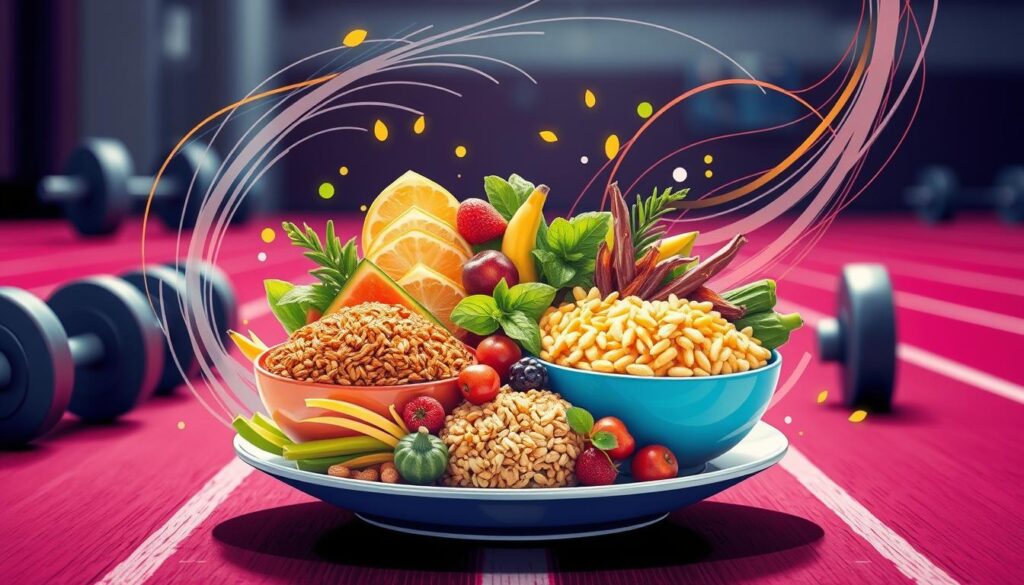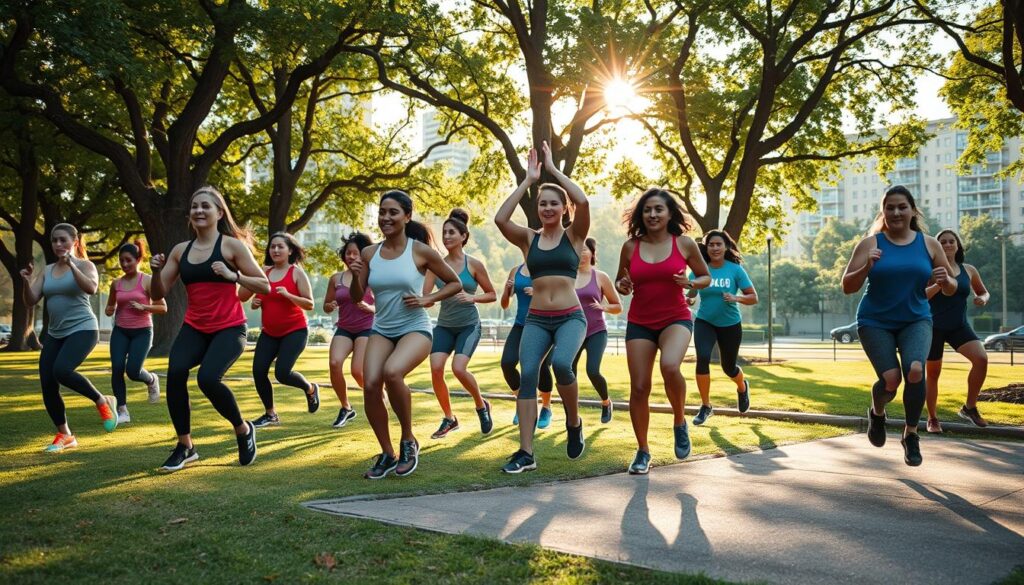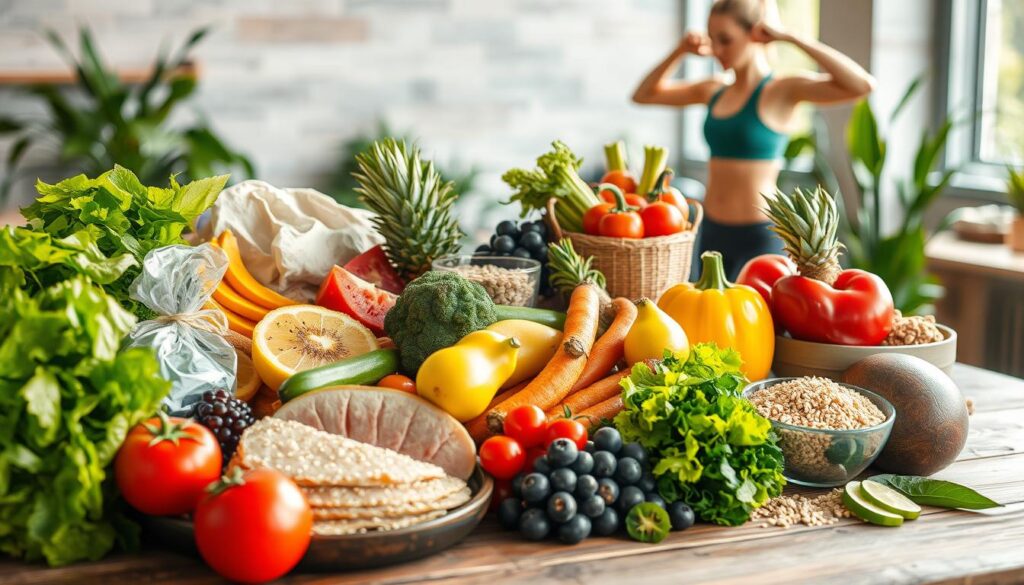Are you tired of dealing with stubborn body fat? Do you want a leaner, more toned body? You’re in the right place. Losing fat doesn’t have to be hard. With the right steps and dedication, you can cut fat fast and feel healthier and more confident.
Effective fat loss tips include smart eating, exercise, and lifestyle changes. By learning the basics of fat loss, you can unlock your body’s fat-burning power. Say goodbye to stubborn body fat and hello to a leaner you!
Key Takeaways
- Sustainable fat loss requires a combination of dietary changes, exercise, and lifestyle modifications.
- Tracking calorie intake and prioritizing protein-rich foods can help boost metabolism and keep you feeling full.
- Incorporating high-intensity interval training (HIIT) and resistance training can effectively burn fat and preserve muscle.
- Optimal sleep, stress management, and intermittent fasting strategies can support your fat loss journey.
- Avoiding common mistakes, such as restrictive dieting and excessive cardio, is crucial for long-term success.
Understanding Body Fat and Weight Loss Fundamentals
Getting a healthy, lean body means knowing about body fat. Fat is good for our bodies, but too much is bad. It can cause obesity, diabetes, and heart disease.
Types of Body Fat and Their Impact on Health
There are two kinds of body fat. Subcutaneous fat is under the skin. Visceral fat is around the organs. Visceral fat in the belly is very bad for health.
The Science Behind Fat Loss
Fat loss happens when we burn more calories than we eat. Hormones like insulin and leptin help control this. Knowing how fat loss works helps us make good weight loss diet plans.
Setting Realistic Fat Loss Goals
It’s important to set achievable fat loss goals. Losing 1-2 pounds a week is best. This slow pace helps avoid losing muscle and other bad effects.
| Metric | Healthy Range |
|---|---|
| Body Fat Percentage | 18-25% for women, 10-20% for men |
| Waist-to-Hip Ratio | Less than 0.85 for women, less than 0.9 for men |
| Visceral Fat Level | Less than 10 for women, less than 13 for men |
Learning about body fat, fat loss, and setting goals is key. It helps you start on the path to a healthier, more confident you.
How Cut Fat Through Dietary Changes
Dietary changes are key to losing body fat. Smart choices and nutrient-dense, low-fat meals can start your fat-loss journey.
Reduce refined carbs like white bread and sugary snacks. Eat more protein to control hunger and boost metabolism. Add fiber-rich fruits, veggies, and whole grains for fullness and fat loss.
Healthy fats from olive oil, nuts, and avocados help too. They regulate hormones, improve insulin sensitivity, and give energy for daily tasks.
- Limit refined carbohydrates and increase protein intake
- Consume more fiber-rich fruits, vegetables, and whole grains
- Include healthy fats from sources like olive oil, nuts, and avocados
| Nutrient | Benefits for Fat Loss |
|---|---|
| Protein | Helps control appetite, boosts metabolism |
| Fiber | Promotes feelings of fullness, aids in fat loss |
| Healthy Fats | Regulates hormones, improves insulin sensitivity, provides sustained energy |
Make these dietary changes to focus on low-fat meal plans and healthy fat burning foods. This will help you reach your fat-loss goals and improve health.
The Power of Protein in Fat Loss Journey
Protein is key in your weight loss diet. It boosts your metabolism and helps you feel full. It also keeps your muscles strong, which is important for losing fat.
Choosing the right proteins and eating them at the right times can change your fat loss journey. It helps you reach your body goals.
Best Protein Sources for Fat Loss
For fat loss, eat lean, high-quality proteins. These include:
- Lean meats (chicken, turkey, lean beef)
- Fish and seafood (salmon, tuna, shrimp)
- Eggs
- Dairy products (Greek yogurt, cottage cheese)
- Plant-based options (tofu, tempeh, legumes)
These foods give you the amino acids you need. They are also low in calories, making them great for a weight loss diet.
Optimal Protein Timing and Portions
Eat protein all day, especially after working out. This helps your muscles grow and repair. It stops you from losing muscle when you’re eating fewer calories.
Try to eat 1.6-2.2 grams of protein for every kilogram of your body weight each day. This helps you lose fat and keep your muscles.
Protein’s Role in Muscle Preservation
Keeping your muscles is key when you’re trying to lose fat. Eating enough protein and doing strength training helps. It keeps your muscles and boosts your metabolism.
By focusing on protein, you keep your muscles while losing fat. This is important for a successful fat loss journey.
“Protein is the foundation for building and maintaining muscle mass, which is essential for a successful fat loss journey.”
Choosing the right proteins and eating them at the right times is important. It makes a big difference in your weight loss diet and body goals.
Strategic Carbohydrate Management
Managing carbs is key to losing body fat. By controlling when and how much you eat, you boost energy and keep muscles strong. This helps you lose fat too.
Carb cycling is a smart way to manage carbs. You switch between eating more carbs and less. This mix helps your body in different ways.
- More carbs fuel your workouts and help muscles grow.
- Less carbs help burn fat, especially when you’re lifting weights.
For a low-fat meal plan, choose complex carbs. Eat whole grains, veggies, and fruits. They give you fiber, vitamins, and minerals. This makes you feel full and keeps your blood sugar steady.
| Carb Cycling Example | Daily Carb Intake (% of total calories) |
|---|---|
| High Carb Day | 45% |
| Moderate Carb Day | 30% |
| Low Carb Day | 15% |
Carb management is personal. Try different patterns to see what works for you. This will help you reach your fat loss goals.

Healthy Fats for Enhanced Fat Burning
Many think eating fats makes you fat. But, healthy fats help you lose weight. Omega-3s boost your metabolism and cut down on inflammation. You can find them in fatty fish, nuts, seeds, and avocados.
Monounsaturated fats in olive oil and nuts also help with belly fat. But remember, fats have lots of calories. So, eat them in small amounts to stay healthy.
Essential Fatty Acids and Weight Loss
Omega-3s in fatty fish like salmon and mackerel aid in fat loss. Experts say eat two servings (3 ounces each) of these fish weekly for the best results.
Best Sources of Healthy Fats
- Fatty fish (salmon, mackerel, sardines, herring)
- Nuts (almonds, walnuts, pecans)
- Seeds (chia, flax, hemp)
- Avocados
- Olive oil
Portion Control for Dietary Fats
Healthy fats are important but have lots of calories. It’s key to control how much you eat. Start with small amounts, like 1-2 tablespoons of olive oil or a handful of nuts. Then, adjust based on your weight loss goals.
“Healthy fats are crucial for fat loss, as they support metabolism and reduce inflammation.”
Exercise Strategies for Maximum Fat Loss
If you want to cut fat and burn fat quickly, the right exercises are key. Mixing cardio and strength training is a smart move. It helps you lose fat in a few ways.
High-Intensity Interval Training (HIIT) is a top choice for burning fat. It’s short, intense workouts followed by rest. This method burns calories fast and keeps your metabolism up after you’re done.
Strength training is also vital for losing fat. It builds lean muscle, which helps you burn calories even when you’re not moving. Try to do strength training two to three times a week.
Experts say to exercise at least 150 minutes a week. This can be moderate or vigorous activity. Add two to three strength training sessions for the best results.

It’s important to find exercises you like and can keep up with. Try different workouts. Find a mix of cardio, strength training, and fun activities that keep you going.
The Role of Sleep and Stress Management
To lose fat, you need more than just good food and exercise. Sleep quality and stress control are key. They help your body burn fat better.
Sleep’s Impact on Fat Loss Hormones
Try to sleep 7-9 hours each night. Not sleeping well can make you store more fat. It also messes with hunger and fullness hormones.
Stress Reduction Techniques
- Try meditation, yoga, or deep breathing to lower stress. This helps with fat loss.
- Exercise often to reduce stress and sleep better.
- Stay away from caffeine in the afternoon and evening. It can mess with your sleep.
- Have a calm bedtime routine to get ready for sleep.
Focus on sleep and stress to help your body how cut fat and reduce body fat. These are important for your health and losing fat.
“Sleep is the foundation for a healthy lifestyle, and it’s one of the most underrated components of weight loss and overall well-being.”
Intermittent Fasting for Fat Loss
Looking for a good way to lose fat? Intermittent fasting might be what you need. It’s about fasting and eating in cycles. This can help you lose weight.
The 16/8 method is popular. You fast for 16 hours and eat in an 8-hour window. Studies say it can lower blood pressure and help you eat less. A 2023 review found it works well for adults trying to lose weight.
The 5:2 diet is another option. You eat normally for 5 days and then eat very little for 2 days. It can help you lose weight and control blood sugar.
| Intermittent Fasting Method | Fasting Window | Potential Benefits |
|---|---|---|
| 16/8 | 16 hours fasting, 8 hours eating | Weight loss, reduced hypertension, decreased food intake |
| 5:2 Diet | 5 days normal eating, 2 days reduced calorie intake | Weight loss, improved blood glucose control |
| Alternate-Day Fasting | Fasting one day, eating normally the next | Weight loss, comparable to daily caloric restriction |
Intermittent fasting can also improve your brain and heart health. It might even help people with type 2 diabetes not need insulin.
But, it’s not for everyone. Kids, teens, pregnant women, and those with eating disorders should not try it. Always talk to a doctor before starting. They can help you decide if it’s right for your fat loss tips and weight loss diet goals.
“Intermittent fasting has been associated with benefits such as improved thinking and memory, heart health, physical performance, type 2 diabetes and obesity management, and tissue health.”
Building Sustainable Fat Loss Habits
Long-term weight loss isn’t about quick fixes. It’s about making lasting changes. Start by planning your meals and tracking your progress. This helps you stay on track and improve your health.
Creating a Weekly Meal Plan
Meal planning is key to losing fat. It helps you avoid unhealthy choices. A good meal plan gives you the nutrients you need to lose weight.
- Eat whole, nutrient-rich foods like lean proteins and healthy fats.
- Make meals ahead of time to save time and avoid bad choices.
- Try new recipes to keep your meals exciting.
Progress Tracking Methods
It’s important to watch your progress. Track your measurements, photos, and body fat. This shows if your plan is working.
- Measure your waist, hips, and thighs to see body changes.
- Take photos to see your progress visually.
- Use a body fat tool to track your fat levels.
Staying consistent is key to losing fat. By keeping up with your habits and tracking your progress, you’ll reach your goals. This will also improve your health and well-being.
| Metric | Baseline | 4 Weeks | 8 Weeks | 12 Weeks |
|---|---|---|---|---|
| Body Weight | 180 lbs | 175 lbs | 170 lbs | 165 lbs |
| Waist Circumference | 36 inches | 34 inches | 32 inches | 30 inches |
| Body Fat Percentage | 25% | 22% | 19% | 16% |
Supplements and Natural Fat Burners
While a balanced diet and regular exercise are key for losing fat, some supplements can help more. They come from natural ingredients or lab-tested formulas. These supplements can burn fat quickly and keep you healthy.
Caffeine and Green Tea Extract
Caffeine boosts your metabolism, helping you burn up to 16% more calories. It also helps your body use fat for energy, especially if you’re a bit overweight. Green tea extract has caffeine and polyphenols that may help you lose fat too.
Protein Supplements
Protein is vital for keeping muscle mass when you’re losing weight. It helps keep your metabolism healthy. Protein supplements can help you get more protein and aid in fat loss supplements.
Natural Fat Burners
- Capsaicin (from chili peppers) – Boosts metabolism and aids in releasing stored fat.
- Apple Cider Vinegar – May help reduce cravings and improve digestion.
- Garcinia Cambogia – Contains hydroxycitric acid, a natural fat-burning substance.
- Raspberry Ketones – Produced in response to fat breakdown.
These natural ingredients might help a bit, but they’re not a full replacement for a healthy lifestyle. Always remember, supplements should add to your diet and exercise, not replace them.
Potential Risks and Considerations
Fat loss supplements aren’t checked by the FDA, and some might be harmful. Always talk to a doctor before trying new supplements. Be careful of products that promise too much, too fast.
The best way to lose fat is through diet, exercise, and patience. Supplements can help, but they shouldn’t be the main focus of your fat loss journey.
Common Fat Loss Mistakes to Avoid
When you’re trying to lose fat, it’s important to avoid common mistakes. Crash dieting is one big mistake. It can cause you to lose muscle and slow down your metabolism. This makes it harder to lose weight.
Another mistake is doing too much cardio and not enough strength training. Strength training helps build lean muscle. This boosts your metabolism and helps you lose fat.
Don’t forget how important sleep and managing stress are. Not enough sleep and too much stress can mess with your hormones. This makes losing fat harder. Also, don’t forget about hidden calories in drinks like sugary beverages and alcohol.
It’s easy to think you burn more calories than you do during exercise. But, you might eat more calories than you think. This makes it hard to know how many calories you need to lose. Stick to making healthy lifestyle changes for the best results.


A Life-Changing Experience with This Weight Loss Supplement (Nagano Tonic)
I’ve always struggled with finding a weight loss solution that actually works for me. Like many, I’ve tried numerous diets, exercise routines, and supplements over the years—some worked for a short time, but nothing ever gave me long-term results. That was until I decided to try the weight loss supplement I found : Link to the Supplement.
From the moment I started using it, I noticed a difference. Not only did I feel more energized, but my cravings also became more manageable. The best part? I started seeing results much quicker than I anticipated! Over the course of just a few weeks, I noticed a significant reduction in belly fat and overall weight loss that I hadn’t been able to achieve before.
What makes this supplement stand out from all the others I’ve tried is how it supports me in my daily routine without any jitters or energy crashes. I’m able to stay focused and motivated, which has made it easier to stay on track with my diet and exercise plan.
This product truly exceeded my expectations, and I feel more confident and healthier than ever before. If you’re struggling with your weight loss journey like I was, I highly recommend giving this supplement a try. It’s been a game-changer for me, and I’m sure it can work wonders for you too!
Contant Them on email .. tonicnagano50@gmail.com
I’ve tried so many weight loss products over the years, but nothing worked like this supplement! Since I started using it, I’ve noticed a big difference in my energy levels and appetite control. In just a few weeks, I’ve lost weight and feel so much better. It’s been easy to stick with, and the results speak for themselves. Highly recommend this to anyone looking to make a real change!
wasn’t sure what to expect, but this weight loss supplement has really impressed me! After just a few weeks of use, I’ve already dropped a few pounds and feel more motivated to stay active. It’s helped curb my cravings and boosted my energy throughout the day. I’m excited to keep going and see even better results. Definitely worth trying!
Reach them on tonicnagano50@gmail.com
I was skeptical at first, but this supplement has truly made a difference in my weight loss journey. I’ve lost weight without feeling deprived or sluggish. My cravings are under control, and I feel more confident in my body. It’s easy to incorporate into my daily routine, and the results speak for themselves. I’m so glad I gave it a try!
Thanks David, i do use the link to make my purchase. you can get too here http://surl.li/iasppy
I’ve tried so many weight loss products, but this one has been by far the most effective. In just a few weeks, I’ve noticed a visible difference in my body and energy levels. It’s helped me stay on track without the constant hunger pangs and cravings. I’m really happy with my progress and can’t wait to see where I’ll be in another month!
This Nagano Tonic has been amazing! In just a few weeks, I’ve lost weight, feel more energized, and my cravings are under control. Highly recommend it!
Thats the link to purchase http://surl.li/iasppy